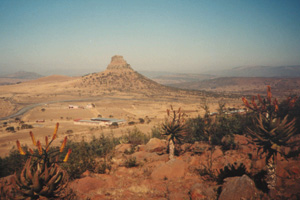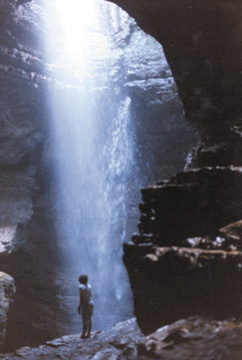geotimesheader
Where
on Earth?
Do you have slides and photos you've collected from field work or
vacations? Every month, we'd like to feature one of your photos from anywhere
in the world and invite other readers to guess where it was taken. Look
every month in the print Geotimes for a new photo. Following are
clues, answers and winners from past issues.
Submit photos for Where
on Earth?
| The first three readers to identify the location
pictured in the current print version of Geotimes receive a Brunton
8099 EclipseTM compass and the first 10
will receive a Where on Earth? T-shirt. Please note that all contestants
are eligible to win one compass per year. |
Answers to
the September and August photo
contests:
Archive
of old answers
September
clues & answer:
 |
Clues:
1.
The cap rock of the hill is a dolerite sill that formed during the breakup
of Gondwanaland. The sill intruded sedimentary rocks that form the rest
of the hill and surrounding plain. They belong to a lithologic group that
contains this country's main source of coal.
2.
In 1879, an indigenous army defeated British troops here in the first major
battle of an eight-month war.
3.
On Christmas Day in 1497, Portuguese explorer Vasco de Gama sighted the
coast of the province in which this hill is located. This sighting inspired
the province's name.
Scroll down for the answer
... |
Answer:
Isandhlwana Hill in the Kwazulu Natal Province of South Africa. Isandhlwana
Hill is a Karoo dolerite (Jurassic age) intrusive into Permian shales/sandstone
of the Pietermariztburg and Vryheid Formations, Ecca Group, Karoo Supergroup. |
September winners:
John L. Snyder — Arlington, Va.
William Smith — McLean, Va.
George Dasher — Elkview, WV
David T. King, Jr. — Auburn, Ala.
David J. Wronkiewicz — Rolla, Mo.
William M. Jordan — Lancaster, Penn.
Bill Laughlin
Jesse Dann — Cambridge, Mass.
Skip Blanchard
Dick Swainbank — Alaska
August
clues & answer:
 |
Clues:
1.
This cave formed in Mississippian limestones that were themselves formed
in an inland sea 300 million years ago. Its pit, the site of large waterfalls
during wet weather, drops 142 feet from the surface and is a popular spot
for rappelling.
2.
Cherokee used nearby caves as a refuge from the elements. The caves show
signs of intermittent human habitation for almost 10,000 years.
3.
The cave is located in the northeast corner of a state that is home to
the nation's premier society for the study, exploration and conservation
of caves.
Scroll down for the answer
... |
Answer:
Stevens Gap Cave in the northeastern corner of Alabama, in Jackson
County. |
August winners:
Bill Torode — Huntsville, Ala.
Jim Hall — Madison, Ala.
George Dasher — Elkview, W.V.
David Williamson — Shreveport, La.
Billy Morris — Rome, Ga.
James Currens — Lexington, Ken.
Bill Balfour — Blacksburg, Va.
Ray Yang — Temple City, Calif.
Rob McDowell — Atlanta, Ga.
Geary Schindel — San Antonio, Texas

